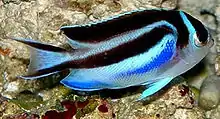Genicanthus bellus
Genicanthus bellus is an angelfish that occasionally makes its way into the aquarium trade. Its common names are the bellus angelfish and ornate angelfish.
| Bellus angelfish | |
|---|---|
 | |
| Genicanthus bellus female | |
| Scientific classification | |
| Kingdom: | |
| Phylum: | |
| Class: | |
| Order: | |
| Family: | |
| Genus: | |
| Species: | G. bellus |
| Binomial name | |
| Genicanthus bellus (Randall, 1975) | |
Description
They are a mid-sized angelfish reaching a maximum of 7in/18 cm at adulthood.[2] Genicanthus bellus are sexually dimorphic, meaning the appearance between males and females is discernible. The females will be blue, black, and white to gray in coloration with horizontal black, white, and blue stripes along the body which shift to vertical striping near the head. The males will be predominantly gray with a yellow stripe running horizontally across the body. Males will often have a yellow stripe that runs along the base of the dorsal fin. Both males and females will have a tail that tapers into the body, giving them the 'swallowtail' appearance.
Diet
The bellus angelfish is an omnivore, eating mostly zooplankton and marine vegetation, specifically algae in the wild. In captivity, they will also accept frozen and meaty foods such as brine shrimp, mysis, and shellfish. They will eat many greens, particularly dried algae, in the home aquarium.
Range
It is found in various ocean reefs, particularly in the western Pacific and eastern Indian Ocean. The fish is also, although less commonly, found in the Philippines and the island chains as far east as Tonga. The bellus angelfish is typically found at depths of 300 ft.
In the aquarium
The bellus angelfish is a moderately difficult fish to maintain in captivity. They are not for the inexperienced aquarist. At a minimum, they should be kept in a 70-gallon tank for a single specimen; with a tank size of 120 gallons or more, for a pair. They are peaceful aquarium inhabitants and will rarely bother their tankmates. Just about the only exception is when kept with other angelfish, particularly of the genus Genicanthus. Also, no more than one male should be kept in a system. A single male can be maintained with multiple females. They are reef-safe, and can be kept with any invertebrates. Possible tankmates include clownfish, blennies, gobies, Chromis, butterflyfish, and small lionfish and eels.
A reef temperature of 78–80 °F (26–27 °C) is ideal for maintaining the bellus angelfish.
References
- Pyle, R., Myers, R. & Craig, M.T. 2010. Genicanthus bellus. The IUCN Red List of Threatened Species 2010: e.T165864A6151980. https://dx.doi.org/10.2305/IUCN.UK.2010-4.RLTS.T165864A6151980.en. Downloaded on 20 December 2020.
- "Genicanthus Bellus". Saltwater,aqua-fish. Retrieved 2009-04-11.
- Froese, Rainer and Pauly, Daniel, eds. (2008). "Genicanthus bellus" in FishBase. December 2008 version.
| Wikimedia Commons has media related to Genicanthus bellus. |
